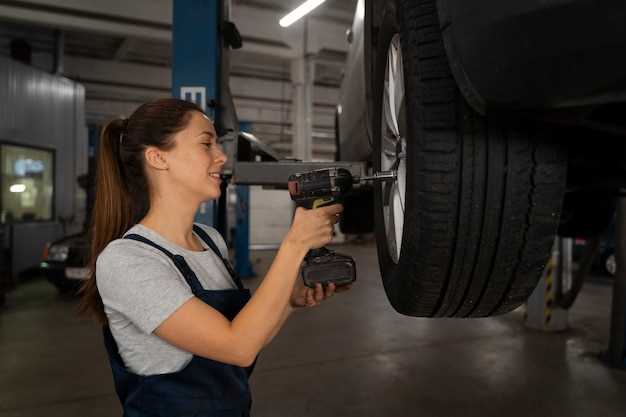
Tire maintenance is an essential aspect of vehicle ownership that directly impacts safety and performance. Regular tire rotation is a crucial practice that helps ensure even wear across all four tires, ultimately extending their lifespan and improving driving stability. Understanding when and how to rotate your tires can prevent uneven tread wear, which not only affects traction but can also lead to costly replacements.
In this guide, we will explore the best practices for tire rotation, detailing recommended intervals and techniques based on your vehicle type and driving conditions. By adhering to a consistent maintenance schedule, you can significantly enhance the longevity of your tires and ensure a safer driving experience. Proper tire care goes hand in hand with understanding the signs of wear and knowing how to respond to them. Let’s dive into the essential elements of tire rotation to help you maximize the performance of your vehicle.
When and How Often to Rotate Your Tires

Tire rotation is a crucial aspect of vehicle maintenance that helps ensure even tire wear and prolongs the lifespan of your tires. It is generally recommended to rotate your tires every 5,000 to 8,000 miles, although this can vary depending on your vehicle type, driving habits, and tire design. Consulting your owner’s manual for specific guidelines is essential, as different vehicles may have unique recommendations.
Factors such as uneven wear patterns, tire type, and road conditions can influence how frequently your tires should be rotated. If you frequently drive in harsh conditions or have a heavy load, consider rotating your tires more often. Additionally, regular check-ups can help identify any irregular wear issues early, allowing for timely tire maintenance.
When performing a tire rotation, the process typically involves moving the front tires to the rear and the rear tires to the front. In some cases, a crisscross pattern may be more appropriate, especially for directional tires. Always ensure that tires are properly balanced and inflated during this maintenance task to maximize performance and safety.
By adhering to a consistent tire rotation schedule, you can enhance your tires’ performance and improve overall vehicle safety, reducing the risk of blowouts or loss of traction on the road.
Step-by-Step Tire Rotation Procedures for Different Vehicle Types

Proper tire rotation is essential for maintaining even wear and enhancing the longevity of your tires. The procedures may vary depending on your vehicle type. Below are detailed steps tailored for various categories of vehicles.
1. Front-Wheel Drive Vehicles
For front-wheel drive vehicles, the standard rotation pattern is a straightforward process:
- Start by loosening all lug nuts on the front tires while the vehicle is still on the ground.
- Lift the front of the vehicle with a jack and securely support it with jack stands.
- Remove the front tires and place them on the rear axle, swapping their positions (left to right and right to left).
- Install the rear tires onto the front axle without changing their positions.
- Once all tires are replaced, lower the vehicle and securely tighten each lug nut in a crisscross pattern.
2. Rear-Wheel Drive Vehicles
For rear-wheel drive vehicles, use a different approach:
- Loosen the lug nuts of all four tires while the vehicle remains on the ground.
- Raise the vehicle using a jack and securely support with jack stands.
- Remove the rear tires and place them on the front axle, switching left to right.
- Move the front tires to the rear axle, maintaining their positions.
- Lower the vehicle and tighten the lug nuts in a crisscross manner.
3. All-Wheel Drive Vehicles
All-wheel drive vehicles typically require a more systematic rotation:
- Loosen all lug nuts while the vehicle is still on its wheels.
- Use a jack to elevate the vehicle and secure it with jack stands.
- Remove the tires and reposition them in a diagonal pattern: front left to rear right and front right to rear left.
- Move the rear tires straight to the front without changing their orientation.
- After all tires are secured, lower the vehicle and tighten the lug nuts diagonally.
4. Cross-Pattern Rotation
This method is useful for vehicles with different tire sizes on the front and rear:
- Loosen all lug nuts while the vehicle is grounded.
- Lift the vehicle with a jack and support it with jack stands.
- Switch the front tires diagonally to the rear (left front to right rear and right front to left rear).
- Move the rear tires straight to the front, keeping their positions unchanged.
- Lower the vehicle and tighten the lug nuts in a crisscross pattern.
Following these step-by-step tire rotation procedures will help ensure your tires wear evenly, maximizing their lifespan and providing better handling and safety on the road.
Signs Indicating the Need for Tire Rotation
Regular tire maintenance is essential for vehicle performance and safety. One of the key components of this maintenance is tire rotation. Here are several signs that indicate it may be time to rotate your tires:
Uneven Tread Wear: Inspect your tires for uneven tread wear patterns. If the front tires show signs of more wear than the rear, or vice versa, it’s a clear indication that a rotation is necessary to ensure even tire wear.
Vibrations While Driving: If you experience unusual vibrations when driving, it could signify that your tires are unbalanced or not properly aligned. Rotating the tires can help address these issues and improve ride comfort.
Handling Changes: Noticeable changes in handling, such as pulling to one side, can suggest uneven tire wear. Regular rotation can alleviate these handling issues and contribute to better vehicle stability.
Tire Age: Even if there are no visible signs of wear, tires should be rotated at regular intervals, typically every 5,000 to 7,500 miles. This proactive approach helps maintain optimal performance throughout the lifespan of the tires.
Seasonal Changes: During seasonal transitions, especially between winter and summer, rotating your tires can help adapt to the different driving conditions. This practice ensures that the tires provide reliable traction and handling.
Being proactive about tire maintenance, including rotations, will enhance the longevity of your tires and improve overall vehicle safety. Regularly inspecting your tires for these signs will help you determine the best time for rotation, ensuring optimal performance on the road.




